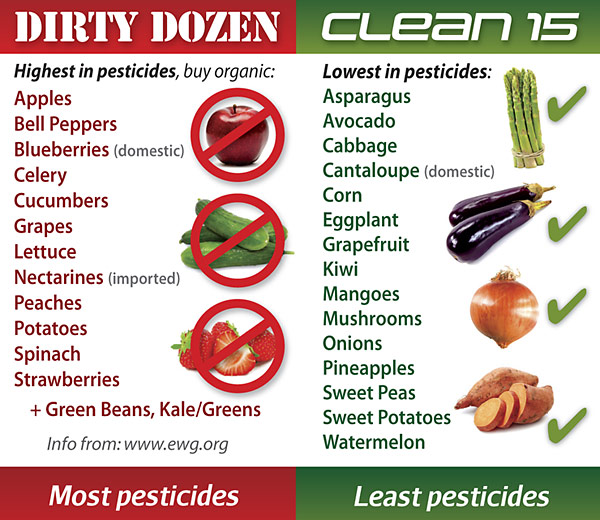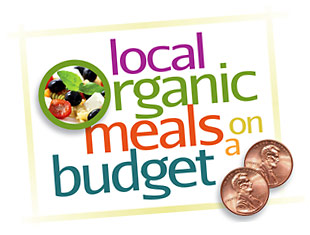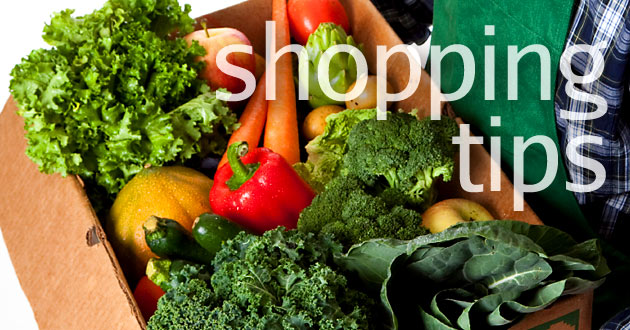Shopping tips
Learn how to save money while shopping for healthier local & organic foods. Click on a topic below to read more:
- 9 Ways to Save Money on Local & Organic Food
- Why buy from your local Farmers Market? (PDF)
- When it's important to buy organic
- Buying organic on a budget
- Seasonal foods: Fresher and less expensive
- Setting up a local and organic pantry
- Local and organic food resources
9 Ways to Save Money on Local & Organic Food
1.) Eat with the seasons. Prices drop on fruits and vegetables during the peak of their growing season when there is a greater supply than demand. Enjoy these seasonal foods when they are in abundance, and if possible, buy in bulk and can or freeze some for future meals.
2.) Choose organic strategically. If you’re not able to purchase all organic vegetables and fruits, a good strategy is to buy organic when the conventional item is high in pesticides. See the Dirty Dozen chart below to help decide where it may be worth it to choose organic.
3.) Partner up. There’s buying power in numbers! Team up with a friend, relative or class member to save money by buying in bulk, stocking up on sales or case discounts, or splitting a share in a CSA (Community Supported Agriculture). You can also partner up to can or freeze together or go berry picking together.
4.) Look for store brand organics, sales, and online coupons. Many times, store brand organic foods are much less expensive and very competitive to conventional. Check online flyers each week for sale items and search websites for coupons. Check out www.frugalliving.about.com and the shopping tips below for money-saving coupons on organic foods and even fresh produce.
5.) End-of-market and in-store discounts. At the end of the Farmers Market you may find vendors with produce that hasn’t sold. Offer to buy a large quantity at a discount – they may be happy to sell it rather than transport it back unsold. Also, many stores have areas with discounted items that are short-dated (soon to expire), slow sellers, or slightly past their prime – yet perfectly good.
6.) Trade your time for farm-fresh food. Want to eat more local and organic foods and get some fresh air and exercise at the same time? Volunteer at a local farm or for the Farmers Market and come home with fresh picked produce and foods in exchange for your time. Visit the Farmers Market website at www.santafefarmersmarket.com and click on “Volunteer” for more info on the many ways to volunteer.
7.) Don’t overbuy. Do you find yourself tossing food because it has spoiled before you were able to eat it? A good chunk of your food budget could be going into the trash – it's estimated that over 20% of food gets thrown away! Buy only what you can realistically eat, cook, can or store. Date your food so you keep better track of the time going by, and be aware of what’s in your fridge and pantry so you don’t overbuy.
8.) Cook in larger quantities. Plan one or two meals each week and think about how you can use one main ingredient to make several different dishes during that week. A roast chicken for example, can be used as an entree when cooked, then later in a soup, a stir fry, a salad, a pasta or any number of variations.
9.) Grow your own! From container gardens to backyard plots to community gardens, there are lots of ways to enjoy locally grown foods. Taking part in growing your own food is a satisfying experience, even if it’s only a few herbs that you can dry and enjoy all year. And if you have an abundance in your garden or from your fruit trees, trade with friends and neighbors for a larger variety, or can or freeze for the future. See our Grow Your Own Food page for more ideas and info.
When it's important to buy organic
Certain fruits and vegetables have high levels of pesticides that pose risks to your health. If you can’t go completely organic, here’s a guide to knowing when it’s best to buy organic or local, pesticide-free foods.
A report issued by the President’s Cancer Panel recommends eating produce without pesticides to reduce your risk of getting cancer and other diseases. And according to the Environmental Working Group (an organization of scientists, researchers and policymakers), certain types of organic produce can reduce the amount of toxins you consume on a daily basis by as much as 80 percent.
The group put together two lists, “The Dirty Dozen” and “The Clean 15,” to help consumers know when they should buy organic and when it is unnecessary. These lists were compiled using data from the United States Department of Agriculture on the amount of pesticide residue found in non-organic fruits and vegetables after they had been washed.
The fruits and vegetables on “The Dirty Dozen” list, when conventionally grown, tested positive for at least 47 different chemicals, with some testing positive for as many as 67. For produce on the “dirty” list, you should definitely go organic — unless you relish the idea of consuming a chemical cocktail.
Visit: www.ewg.org for an expanded list of pesticides found on many different fruits and vegetables.
Top foods to avoid
If you can't always buy organic, here are the top pesticide-laden "Dirty Dozen Fruits & Vegetables" and the least contaminated "Clean 15". Source: Environmental Working Group.
• Download PDF: Food PesticideGuide.pdf

Read related articles about pesticides and health:
On the USA Today website:
"Rankings reflect the amounts of chemicals present on food when it is eaten. Most samples were washed and peeled before testing. Washing with a "produce wash" is unlikely to help remove pesticides because they're taken up by the entire plant and reside on more than just the skin, the report says." www.yourlife.usatoday.com
On the PBS website:
"A new report issued by the President’s Cancer Panel recommends eating produce without pesticides to reduce your risk of getting cancer and other diseases. And according to the Environmental Working Group (an organization of scientists, researchers and policymakers), certain types of organic produce can reduce the amount of toxins you consume on a daily basis by as much as 80 percent." www.pbs.org
Buying organic on a budget
Shopping on a Budget for Organic Food www.organicauthority.com
How to Eat Organically on Modest Means www.wikihow.com
How to Make Buying Organic Affordable www.organicauthority.com
17 tips for buying organic food on the cheap www.bankrate.com
10 Farmers Market Shopping Tips www.localfoods.about.com
How to Save Money at a Farmers' Market www.wikihow.com
Quiz: Know How to Shop a Farmers' Market? www.wholeliving.com
Seasonal foods: Fresher and less expensive
Eating with the cycles of nature is a way to get the freshest food at its natural peak. Our classes will revolve around what's available locally during each season.
Here's a guide to what's in season and nutritional benefits compiled by Santa Fe Nutritionist Laura McCann.
Click to see what's available right now at the Santa Fe Farmers Market.
Build up a local & organic pantry
Having a well-stocked pantry or just some basic staples in the house means that you can shop for fresh vegetables, poultry and meat and come home and create the rest of the meal from your pantry. Here are some suggestions to start with:
• Beans (black, pinto, garbanzo, kidney, etc. dried and canned)
• Chicken / vegetable broths
• Flour (unbleached; whole wheat preferable)
• Garlic and Onions
• Herbs and spices (basil, oregano, parsley, ground cumin, chili powder, sea salt, black pepper, cinnamon, etc.)
• Nuts and Dried Seeds (walnuts, pumpkin, sesame…)
• Oatmeal and other whole-grain cereals
• Olives
• Pasta (whole wheat)
• Raisins / other dried fruits
• Rice (brown)
• Soy sauce (low sodium)
• Tomatoes / Tomato Sauce (pref. organic in glass jars)
• Tuna / Salmon (canned)
• Vegetable Oil (olive, canola…)
• Vinegar (red wine, balsamic, try others)
Tips
Olive oil – Buy good quality organic extra-virgin for salads, dressings, finishing. Buy in the proper quantity for you, oil that sits for months in the light will get rancid.
Canola oil – Buy good quality, organic. This oil, as with all oils, will go rancid as well.
Vinegar – White wine is a good choice if you are just stocking one.
Sea salt, black pepper to grind – Black pepper loses it's flavor quickly, so grind it fresh and taste the difference.
Spices – Bay leaves, cumin seed, fennel seed, dried chiles, cayenne pepper, nutmeg, cinnamon, cloves, cardamon, ground ginger. Buy small quantities as they lose their potency in a few months.
Flours – Organic unbleached all-purpose flour is best. Buy in bulk. If you don't use often, buy small quantities, flour goes rancid in a few months. Store in a cool dry place away from light. Whole grain flours should be stored in the refrigerator.
Sugar – Use raw sugar or brown, the less refined the more nutrients are retained. Just remember it burns more quickly than white sugar. Also, use honey, agave nectar, maple syrup or rice syrup in place of sugar.
Baking powder and baking soda, cornstarch – Baking powder may contain sodium aluminum sulfate, so look for a brand without it. It has a short shelf life, replace after about a year. Cornstarch is good for thickening sauces. If you know you are going to reheat a sauce use flour instead, cornstarch will not hold it’s thickening capability in reheating.
Vanilla bean or vanilla extract – Use only real vanilla extract, artificial extract is made from wood pulp. Organic vanilla is widely available.
Yeast – Buy active dry yeast and store in refrigerator.
Pastas – Stock 2-3 kinds of dried pasta, spaghetti, linguine, rigatoni, penne.
Polenta and cornmeal – Buy small amounts, store in cool dry place or in refrigerator in summer months.
Rice – Stock white and brown rice. Short grain is best for risottos, long grain is good for most other uses. Store away from light.
Quinoa, Aramanth, Couscous – Try these other grains, they are useful in lots of dishes and store just like rice.
Dried beans – Stock several kinds, lentils, black eyed peas, cannellini, pinto, red kidney beans.
Canned goods – Keep canned beans, tuna, tomatoes, salmon and other favorites for additions to quick meals.
Condiments – Salt packed anchovies. Good in salsa verde, bagna cauda, Caesar dressing. They provide a complex saltiness.
Capers – Store in refrigerator. Good in salsa verde, sauces, egg salad, on meats and fish.
Jams, Jellies, Chutneys – Also mustards, mayonnaise
Broths – Stock chicken and beef broths either in cans or concentrated. If you are vegetarian use vegetable or mushroom broths to enhance flavoring.





